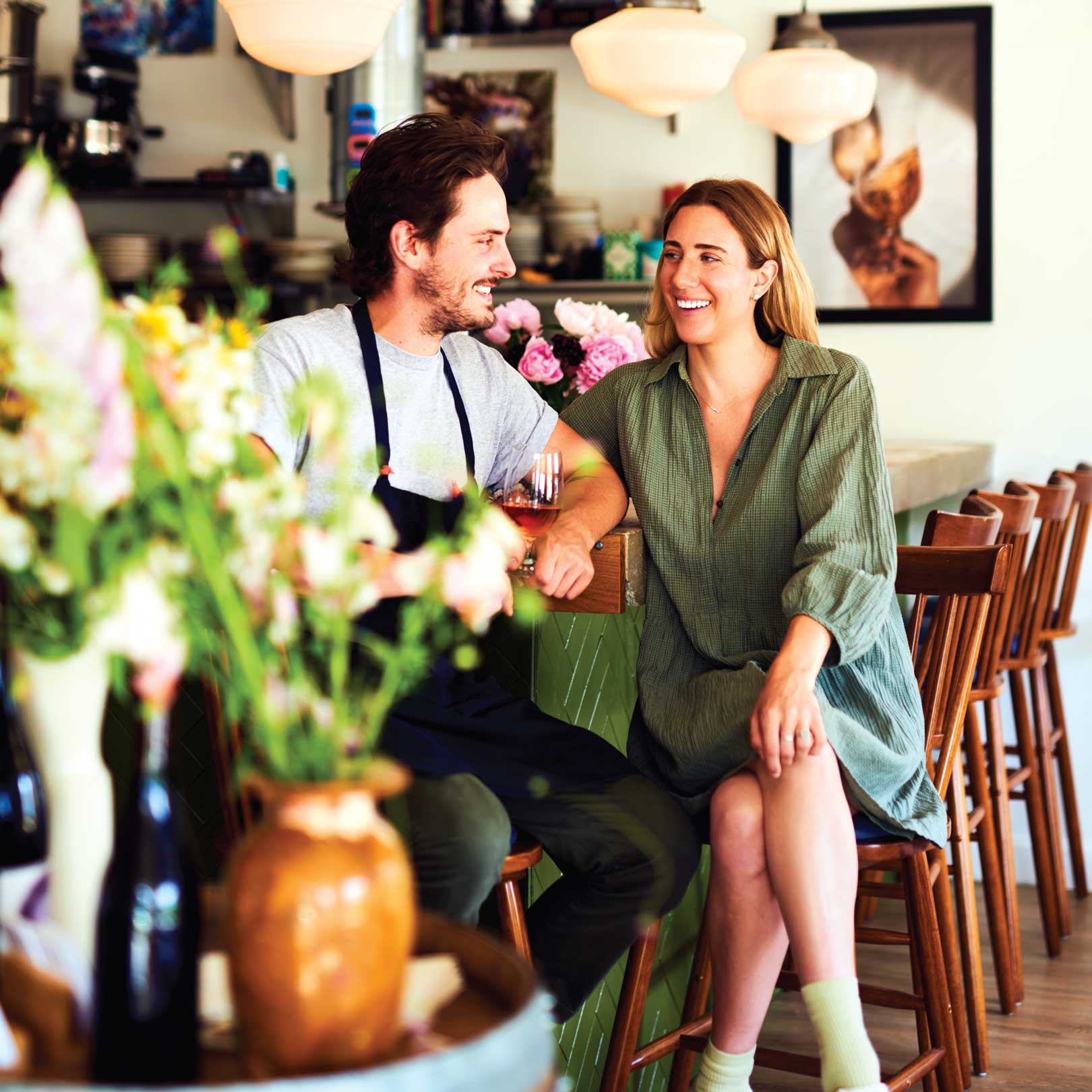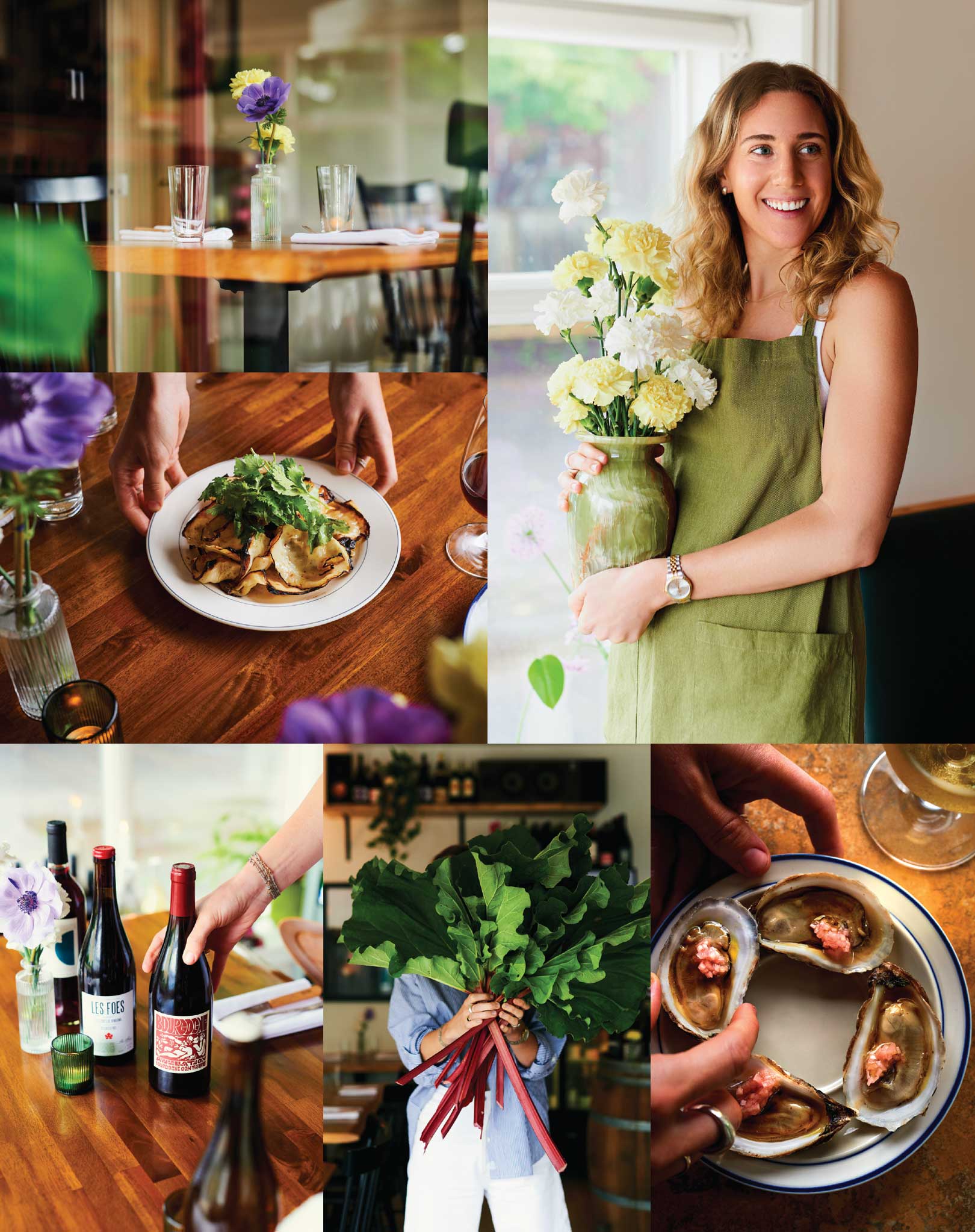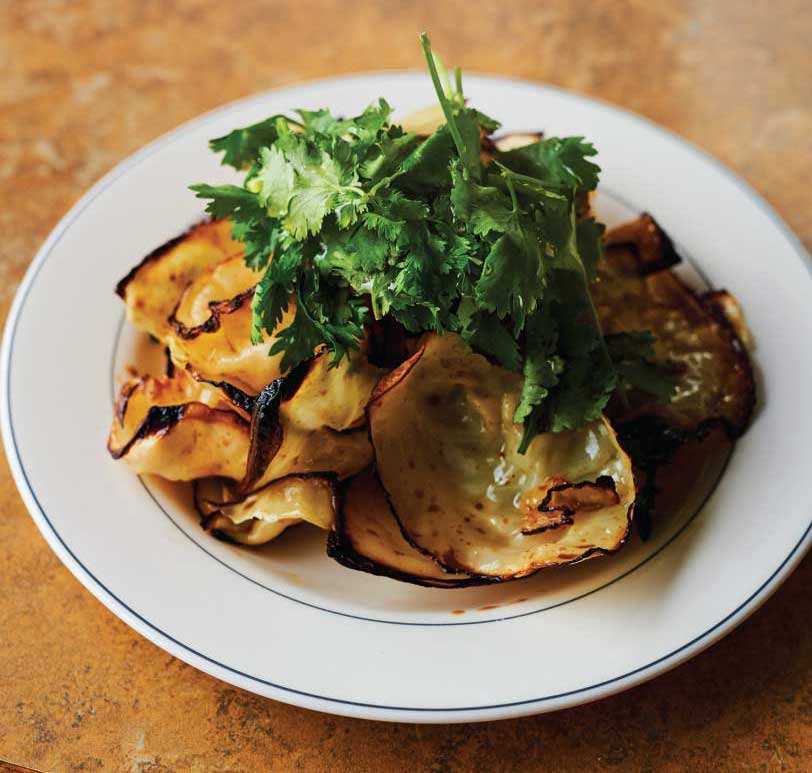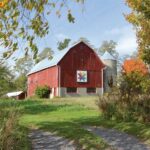


At just 420 square feet, tiny Theia has big aspirations. Opened in 2023 by sommelier Myles Harrison and his fiancée, Margot Kenny, this unassuming little building belies the magic happening inside.
It was the offer of a plum job for Myles Harrison at a Prince Edward County resort that lured the young couple from Toronto in 2022, but when the job suddenly ended, Harrison found himself without an income, and with a 19th century house on 10 acres to maintain.
“It was terrible because we had just bought a house and winter was coming; I was pretty down in the dumps, but I started a handyman business, cooked on the line at another place, and did some landscaping to get by,” recalls Harrison. “After going through Covid and then moving for a job that I lost, I knew I had to keep moving forward – at what pace, I wasn’t sure – but I just had to keep moving forward. There were some moments in that first winter where I was wondering ‘what have we done?’”
But through that whole time, Margot was still working and they pushed through the uncertainty and disappointment. And then one day a friend texted Harrison about a lease coming up in Picton. Two weeks later, he had the keys, and Theia was underway.
The Theia Hypothesis suggests it was the collision of a small planet (Theia) with Earth, that created the verdant world we now live on, formed our moon, and gave us water and the other elements for life. When Harrison learned about that theory, he knew it would be the name of his dream restaurant. And it fits: creating beauty from calamity, making big flavours from a minuscule kitchen, and overcoming adversity happens here. It’s a simple space, in soft greens, natural wood and concrete, with vintage and antique accents, including china from Kenny’s aunt, and a disco ball, of course.
“Our job is to create an environment that allows you to let your walls down and let life really affect you,” says Harrison. “I think about nostalgia a lot and things that stir people – about things that make me comfortable – and if it’s something I like to have around me, I assume there must be other people who like the same things. That’s true hospitality.”
At Theia, Harrison is something of an accidental chef – wine is his passion and profession. Here he’s found the best of both worlds, with an intelligent wine list and a tight menu of dishes.
The menu is small and so is the kitchen; that’s part of Theia’s charm. “The size of the kitchen was a challenge,” says Harrison. “But now I love it. The card is small but we also offer specials based on whatever’s good from the garden that day. We’re not trying to be super weighty here. We’re a wine bar and the food is meant to surprise and support whatever’s happening at your table.”
The wine list is impressive and comprehensive. “We skew toward lower-intervention wineries, wines made with purpose,” says Harrison. “We’re international. We don’t deal with a lot of local producers, and that’s by design. I don’t feel comfortable when you’ve been visiting wineries and then you come here and I sell you a bottle for $60 that you could’ve bought for $30 at the winery. That’s what I see my job as a sommelier is: to put you in touch with something you wouldn’t have had the opportunity to find otherwise.”
Harrison is drawn to things made with purpose: the wine and beer, his playlist, and his garden and restaurant. “If we served to-go food that was more accessible – chicken wings or something – we could probably be busier, but I don’t want to do that. I think that’s one of the reasons this restaurant exists: to be an agent of growth and evolution of a community in general. There’s only one place you can have food like this in the County, and there are many places you can have pasta and chicken wings. I want to do something different to help diversify and maybe add a different spice, variety and to help grow the essence of our community.”
By “community” Harrison is referring to the locals who live here year round. Businesses in the County are very much tourist-driven. The population dwindles substantially after the fall, and as Harrison says, “It’s the weather, it’s really cold, windy, and the squalls pick up quickly. But I don’t blame people. In the wintertime, you just want to stay home, have a fire and roast a leg of lamb. You don’t necessarily want to come out and eat vegetables and stuff; but that’s also why we went with such a small place. In the wintertime, it only takes two or three tables to make the place feel cozy. It’s a beautiful place to be when we’ve got the candles going. I’ve never worked in a tourist destination market before, and it’s a bit unsettling. But I can tell you, no one in Toronto ever came to shovel my walkway when it snowed. The community here is stronger – in the truest sense of the word.”
“I’m happy that we came out here,” he says. “I love our property. Plus, we’d like to have a family one day and this is a great place to have kids. And say what you want about working hard, nothing gives you a sense of purpose like hard work, so that’s what this place has taught me too. Am I working like a dog? Yes. Have I made it to the beach yet? No. But I’m creating something that is truly an extension of me, and people are really enjoying what we’re putting out there.”
Roasted Fall Cabbage
“People really connect with this composition,” says Myles Harrison. “There is something special about using ingredients that people have a certain association with, but in a way they haven’t tried. Cabbage, cumin and hot chili are all very accessible raw materials, but when the vegetable is crunchy and caramelized with the addition of the ultra-umami sauce and the electricity of the chili and cumin, you’re left with a surprisingly light and vibrant fall cabbage dish.”
Ingredients
1 cup of Bragg Liquid Aminos Original or gluten-free soy sauce
2 sprigs fresh rosemary
1 tbsp. honey
1 green fall cabbage
1 tbsp. freshly squeezed lemon juice
1 dried arbol chili
2 tsp. ground cumin
1 cup coarsely picked coriander, including tender small stems
Approximately 2 tbsp. extra virgin olive oil
Directions
- Start by making the sauce. To a small saucepan over medium heat, add Bragg Liquid Aminos Original or gluten-free soy sauce, rosemary and honey. Simmer on low heat until reduced by a quarter, stirring occasionally. When reduced, strain the liquid through a sieve, set aside and allow to cool uncovered.
- Preheat oven to 300F and toast the dried arbol chili for one minute. When toasted, add to a spice grinder and grind into a powder. Combine the ground chili – as much as you like for a little tingle of heat – with the cumin. Set aside.
- Increase oven to 400F. Cut the cabbage into quarters, keeping the core intact. Use some of the oil to coat the flat side of the wedges, arrange on a sheet pan flat side down, and roast for about 7 minutes on the first side. Flip the wedges and return to the oven for a further 7 minutes or until the flat sides have a deep char and the centre is just steamed through. The centre should feel warm while remaining crunchy and the outside should be visibly hot.
- When done, remove from the oven, cut off the core and place wedges into a mixing bowl, add ¼ cup (50mL) of the Bragg sauce, a tablespoon of the chili-cumin spice (more or less to taste), and the lemon juice. Mix the steaming hot cabbage with tongs or two wooden spoons until the cabbage leaves are coated all over, be sure there are no pockets of cumin and chili powder.
- To serve, arrange on a plate by stacking the cabbage leaves, top with fresh cilantro, and finish with a drizzle of good quality extra virgin olive oil.
Serves 2 to 4 as a side dish.
Sunny Stone and Grant van Gameren,
Van Stone Farms
Chef Grant van Gameren rose to fame in 2008 for his nose-to-tail charcuterie when he was chef at Toronto’s Black Hoof, then a groundbreaking restaurant, now gone. The city fell in love with him all over again when he opened the stunning, Barcelona-inspired Bar Raval. Today, he and his family live and work in Cressy, PEC, though he still leads a roster of successful restaurants in Toronto, as well as Harry’s in Picton. Purchased in 2017, Cressy House and Van Stone Farms is a guesthouse and farm sitting on six acres, where he raises veggies for the kitchens of his own restaurants and several others in the County as well: Bocado, Darlings Pizza, Flame + Smith, and of course, Theia, where Myles Harrison keeps on top of what Grant’s gardens are producing in order to create his wine bar menus. In the fall, that means root veggies, lettuces, tomatoes, brassicas and more. “Grant grows with intent as a culinary professional,” says Harrison. “It makes it very interesting; he’s searching for some very cool produce; plus, we go way back.”
Bernard and Joanna Bennett,
Garage Time Brewing
In the wonderful world of beer brewing, after the big guys, there is craft, then micro, and now, nano. That’s super-small and it also means super-agile, so each batch can be lavished with attention and driven by flights of fancy. Since 2021, husband and wife team Bernard and Joanna Bennett have put heart and soul into every 200-litre batch – that’s about 600 cans – they brew in their actual garage in Wellington, PEC. Their idea was to keep the look and vibe of hanging out at a friend’s house while enjoying good company and a cold beer, and that’s what they’ve accomplished. Bernard is also a chef, and draws on this curiosity to impart exciting flavours to the brews, created in a variety of styles – from oak-aged to gose to IPAs – all made with as many natural, fresh and local ingredients as possible. Theia serves their Leo’s Michelada. “Margot and I try to get to southwestern Mexico as often as we can, and we drink a whole lotta micheladas when we’re there,” says Myles Harrison. “And Garage Time makes a good one.”
André Gagné,
Last House Vineyard
Called “hands-on farming, hands-off winemaking,” it’s a recipe for some of the best Chardonnays and Pinot Noirs to come from the limestone soils of Hillier. Owner André Gagné and his family use only grapes grown on their own farm to craft these small-batch wines. The unique terroir produces smaller yields with highly concentrated flavours, and the “hands-on” bit – pruning, weeding, harvesting – is all done by, well, hand. The “hands-off” bit comes to life in the fermentation which relies on naturally occurring yeasts. Gagné adds nothing before bottling and corking by hand – all with a little help from viticulturist Geoff Heinricks. The winery won two gold medals at the 2024 All Canadian Wine Championships for their Electrum 2021 and Cidre Pétillant 2022. The apples come from 135 golden russet trees André planted in 2018. “André is great,” says Myles Harrison. “His wine is very good, but beyond that, André is one of the first people I met when I moved out here, and we bonded over the standards we both aim to achieve.”
Story by:
Signe Langford
Photography by:
Daniel Skwarna/Lumen




